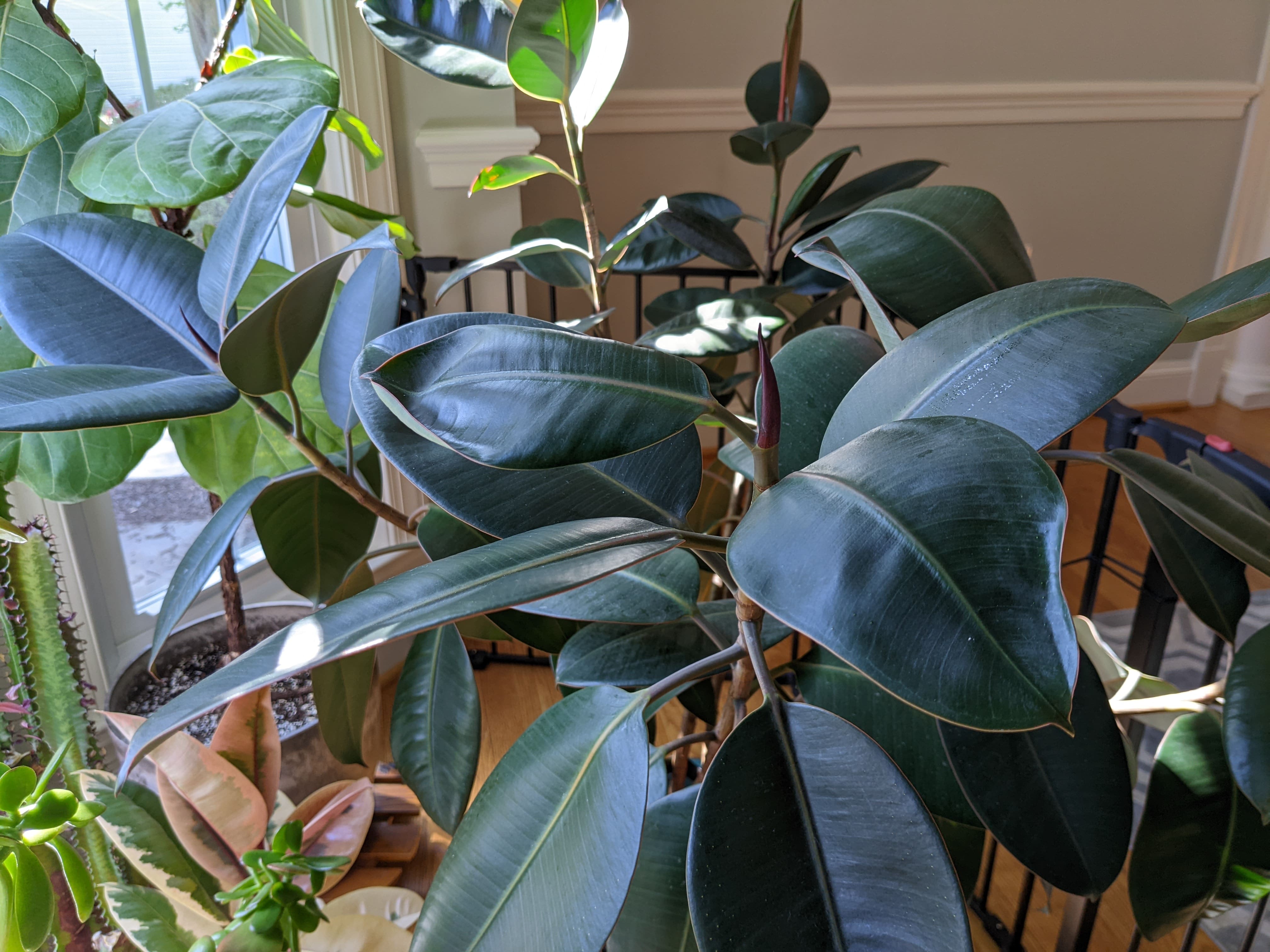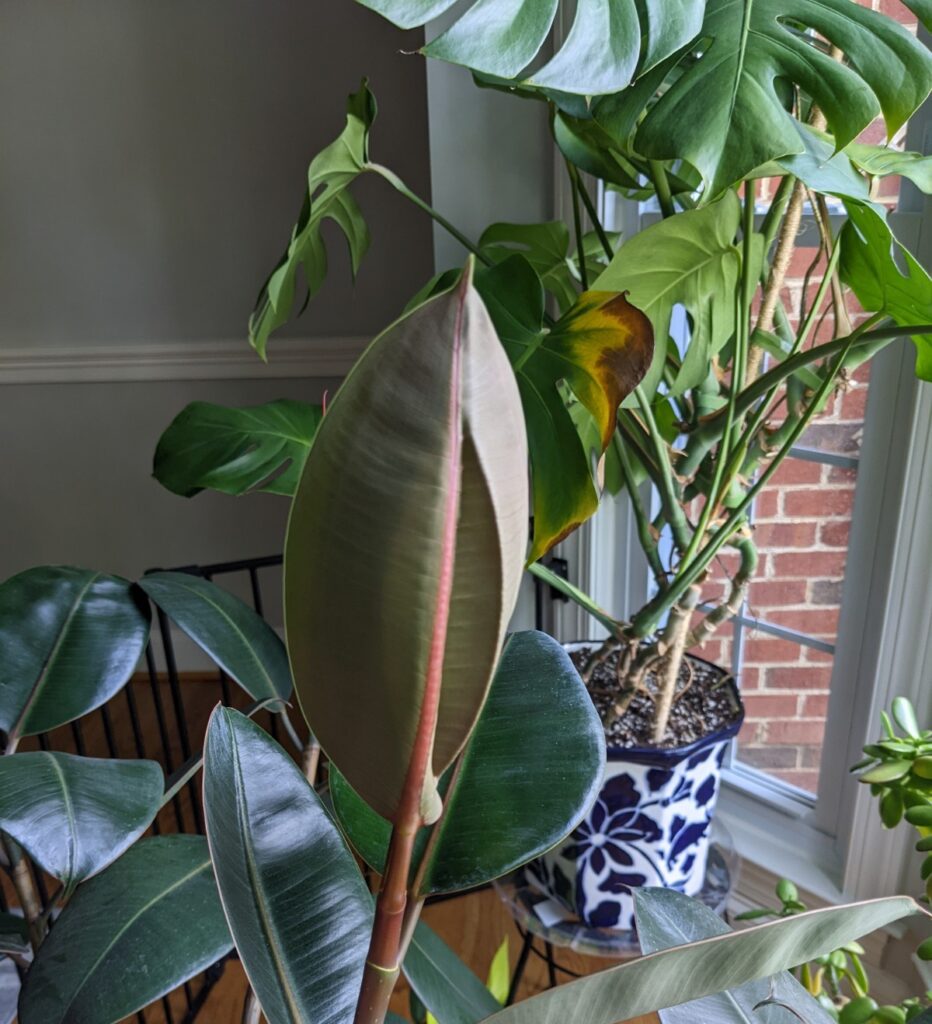Why Are My Ficus Elastica Leaves Curling?
I have a pretty big Ficus Elastica with many trunks. When I was watering it recently I noticed some of the leaves are curling. In an effort to help anyone else who might be experiencing this problem, I decided to write about it. Why are your Ficus Elastica leaves curling? How do you fix and prevent it in the future?

Reasons for Ficus Elastica Leaves Curling
Moisture Issues
A Ficus Elastica with moisture issues can show a variety of signs, leaves curling is one. Some other signs that you may have a moisture issue are leaves beginning to turn yellow or brown. Or the leaves may become droopy. Your plant leaves may even become crisp.
Overwatering
An overwatered Ficus Elastica can display any of the symptoms listed above. Although, the leaves are unlikely to dry out before you see yellowing or drooping if that makes sense. So how do you tell if you have overwatered your Ficus Elastica? You can stick your finger in the soil to see if it feels wet over several days. In addition, make sure your pot has drainage holes that excess water can escape out of. You might also try to carefully lift your plant out of its pot to examine the soil and roots. If you're overwatering, there's a chance that there is damage to the roots in the form of root rot. Once the roots have begun to rot, which is evident by dark and squishy roots, then you will need to root prune, repot, and cross your fingers. If you need more pointers, I have a post on salvaging an overwatered plant.
Underwatering
An underwatered Ficus Elastica can also show the same symptoms as I mentioned above. Just like above, you want to check your soil moisture. If you're not sure if you're overwatering, underwatering, or watering just enough, you can use a soil moisture meter to remove some of the guesswork. As part of your watering routine, you should check the soil moisture before you water this will help prevent you from overwatering in a case when your plant doesn't need water yet. It will also start to give you a better idea of how quickly your plant is drying out to help you become a better waterer overall. If you believe you have been underwatering, you should bottom water your plant in the sink or tub and then monitor the soil moisture diligently from there.
Humidity
The final water issue could be a matter of humidity. In fact, I believe humidity is my current problem or was. As you can see from the picture below I have a leaf on the end of the branch pictured that is wrinkled and curled. When the air is very dry it can prevent the leaves from emerging from the sheath they're in. I think it may just be a little too dry because it's peak summer and all the moisture is evaporating quickly. Low humidity can be addressed with a small humidifier near your plants.

Nutrient Issues
Fertilizing issues may also cause curling or deformed leaves. If you have fertilizer issues, some visible signs you might see from your Ficus Elastica will be yellowing leaves or deformed leaves. Both over-fertilizing and under-fertilizing can cause issues.
Plant Fertilizer
Most common plant fertilizers contain different ratios of the macro-nutrients n-p-k, nitrogen, phosphorus, and potassium. Most fertilizers will show on the label what ratio it contains for these three nutrients. Nutritionally, nitrogen primarily promotes leaf growth, phosphorus promotes root development and budding/fruiting, and potassium is for overall health. If you're experiencing leaf issues it may be that you are deficient or too abundant in nitrogen. Depending on the nutrient issue and the severity, you may need different ratios of fertilizer to fix the issue. You can find high nitrogen fertilizers, low nitrogen fertilizers, and balanced fertilizers.
Fixing Nutrient Issues
It's difficult to tell whether you have been over or under-fertilizing. The first thing to check is whether you have been using the fertilizer as instructed. There should be very specific instructions on dilution, dosage, and frequency of fertilization on the label. The only real way to know if you have a nutrient issue though is to test your soil. These soil rapitests are convenient for that. They are relatively cheap and give you a definitive answer about your soil nutrients. Over-fertilization can be addressed by flushing the soil with water. Under-fertilizing can be addressed by using fertilizer as instructed.
Pest Issues
Pest issues may also cause your Ficus Elastica curling leaves. Damage from pests will show up as leaf discoloration, typically yellowing, but it should look more splotchy and uneven, which looks different from yellowing from watering or nutrient issues. Generally speaking, pests feed on plant matter so you might notice small collections of yellow dots. If pests are feeding on your Ficus Elastica you might also see leaves drooping or even small holes in leaves. If you see actual bugs or tiny webs, you definitely have a pest problem.
Types of Ficus Elastica Pests
A number of pests can attack indoor Ficus Elastica. The most common pests are aphids, spider mites, scale, and mealybugs. Look under your leaves for aphids, scale, and mealybugs. Spider mites make small webs and often collect around the leaf's petiole, leaf tip, and underside. I've successfully battled spider mites on a different Ficus Elastica, which you can check out here.
How to Eradicate Pests
If you notice or suspect that you have pests, you should remove your plant from the general vicinity of other plants as soon as possible. Somehow these pests are really good at hopping plants. I guess that how they survive so it makes sense. Next, remove as many pests as you possibly can. For aphids and spider mites, you can spray your plant off outside with a hose or in the shower. Scale and mealybugs have to be removed manually. People often recommend using alcohol on a cotton swab to do so. Next, you should treat your plant with some kind of pest control. Organic solutions like neem oil can work as well as non-organics like insecticidal soaps. The key is to follow the instructions on the label, which may seem like overkill at first. It is important to treat your plant for weeks though because even when you think they're gone the pest's eggs can still be there to reinfest your plant.
What Happens After You Fix the Problem
The great thing about Ficus Elastica is that they are a pretty resilient plant. They do grow slowly though so it may take time for you to see if what you're doing is working. Unfortunately, you cannot fix the leaves that are already curled though.
Add new comment